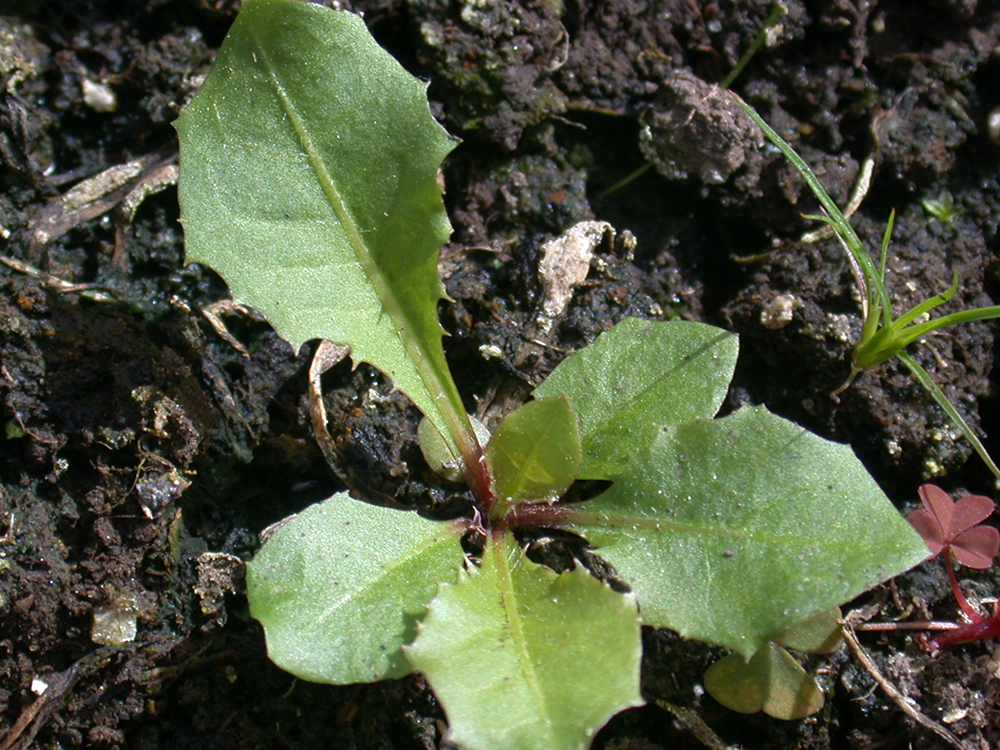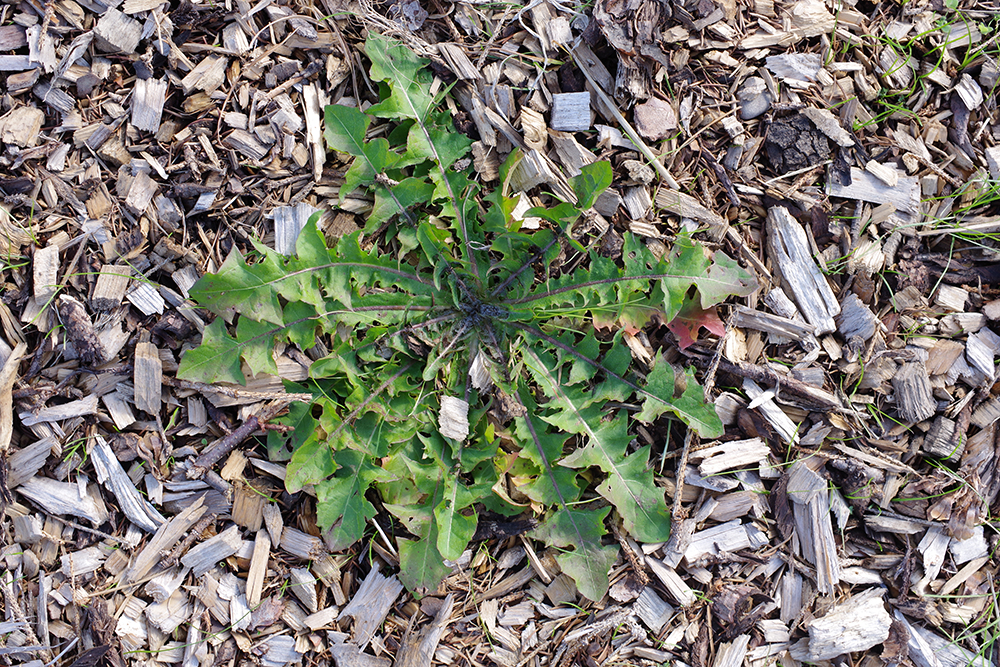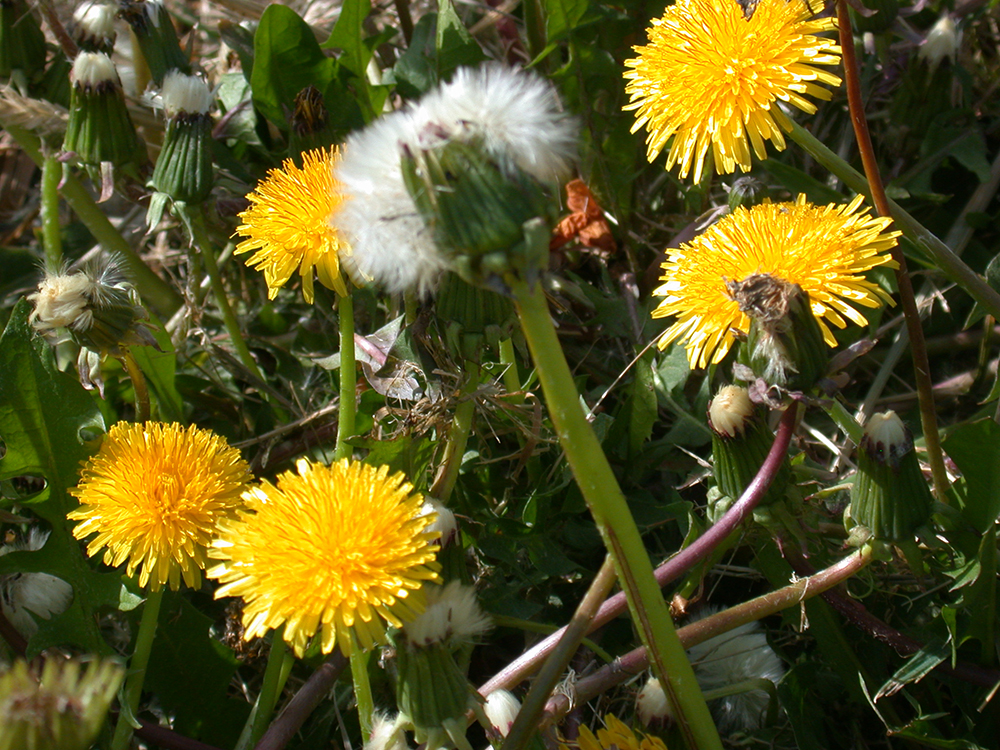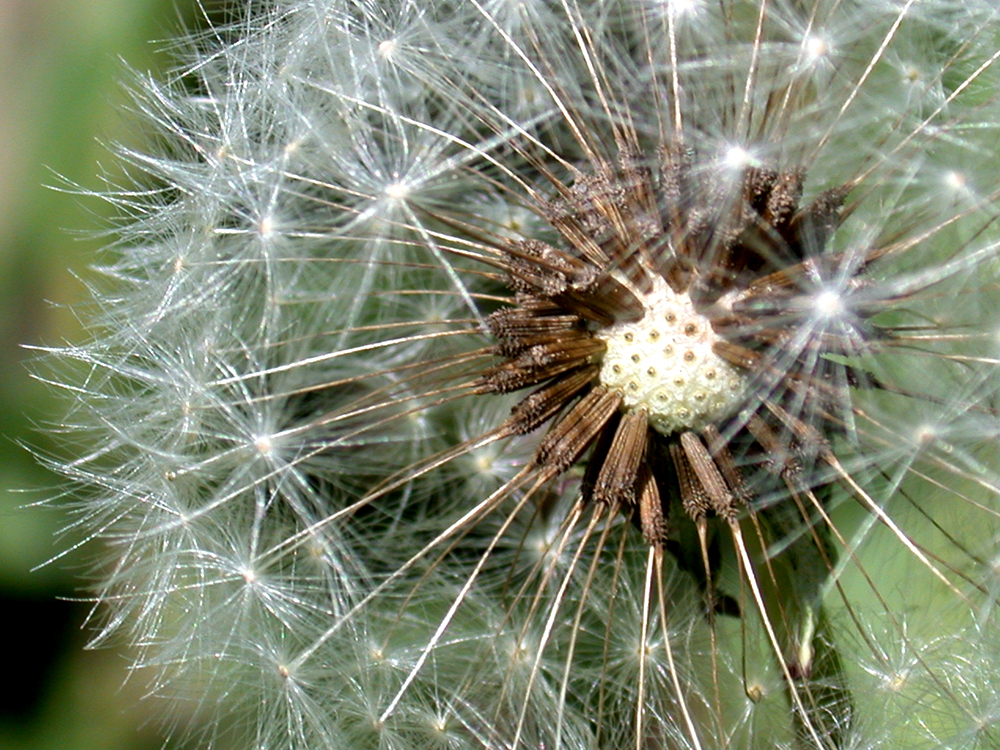Other common names: common dandelion, blowball, cankerwort, faceclock, pee-a-bed, wet-a-bed, lion’s tooth, Irish daisy




Taraxacum officinale F.H. Wigg.
Identification of Dandelions
Family: Aster family, Asteraceae
Habit: Rosette forming, taprooted perennial herb with leafless flowering stalks
Description: Cotyledons are 0.2–0.4 inch long by 0.08–0.14 inch wide, yellow-green, hairless, untoothed, flat, and oval to upside down teardrop shaped. The first true leaves of the seedling are alternate, hairless, spatula to upside down teardrop shaped, and gray-green on their lower surface; edges are wavy, irregularly toothed and lobed at the third leaf stage. Later emerging leaves of the young plants are widely toothed and deeply lobed, with lobe tips pointed towards the center of the rosette. Scattered flat hairs may be present on both sides of the leaf. Mature plants form a basal rosette of leaves. Leaves are stalkless, narrow and deeply divided toward the base, 2–15.5 inches long, deeply lobed. Lobes are triangular, often oppositely paired and point toward the crown. Scattered hairs are occasionally present on the midvein and leaf underside. Large, fleshy taproots may branch and can reach depths up to 6.5 feet. The entire plant exudes milky white sap when cut. Single flowers develop on 2–30 inch-long, hollow, sparsely hairy, leafless, white-green to reddish tinged stalks. The bright yellow flower head is 1–2 inches in diameter, 0.5–1 inch tall and set directly above two rows of long, green, narrow bracts. The outer bract row is curled back to touch the stem, and the inner row encases the immature flower head. The flower head consists of 100–300 yellow petaled flowers, each with five points at the tip. Seeds are gray-yellow to light brown, 0.25 inch long, cylindrical and attached to a feathery pappus by a 0.4 inch-long stalk. The seedhead is gray-white and spherical.
Similar species: Redseed dandelion [Taraxacum laevigatum (Willd.) DC.] is very similar to dandelion, but in contrast to that species, the terminal lobe of the leaf is about the same size as the lateral lobes, and the seeds are red to purple brown. Chicory (Cichorium intybus L.) can be distinguished from dandelion by the prominent, coarse hairs on its older leaves and by its lobes pointing forward, backward and perpendicular to the leaf axis. Common catsear (Hypochaeris radicata L.) has similar yellow flowers, but its stems are tall and branching with scattered leaves and multiple flowers. Annual and perennial sowthistle (Sonchus spp.) have waxy, blue-green leaves with large auricles at the leaf base.
Management of Dandelions
Avoid high K levels in the soil to avoid problems with dandelion. Dandelion competes poorly with forage grasses and grains for K, so when K is in relatively short supply, the grasses win. In contrast, since grasses and grains show a greater response to N and P than dandelion, high N and P levels will favor the grasses. Excessive liming also promotes dandelion.
In pastures, dandelion is more likely to be a problem under continuous stocking than under intensive rotational grazing. With rotational grazing, the leaves will grow upright in response to competition from the grasses, which makes them more susceptible to grazing when the animals are present. In contrast, under continuous stocking, the leaves will be prostrate and hard for the animals to bite, and growth rates are likely to be higher due to reduced competition from the grasses. Dandelion can establish in alfalfa after it is mowed and tends to increase during the alfalfa phase of a crop rotation. Alfalfa can promote dandelion emergence and establishment, especially in small gaps in the alfalfa stand. Mowing alfalfa in the flowering stage is more effective at suppressing dandelion than mowing in the vegetative or bud stage. Seeding forages in narrow row spacing reduces subsequent dandelion density and growth. Although dandelion makes nutritious forage, it slows the drying of hay by up to a full day. Generally, removal of leaves or the uppermost root from established plants has little effect on survival in lawns or hay.
Moldboard plowing is the most effective tillage regimen for controlling severe dandelion infestations: Plowing puts the root crown deep in the soil from which resprouting is difficult, and inversion of the roots decreases the likelihood of sprouts arising from small roots. Conversely, dandelion density often increases with adoption of reduced tillage practices. Resprouting of roots following tillage is less in May than at other times, probably because root reserves are reduced by flowering at that time.
Frequent tine weeding is effective for removing new seedlings that arise following the spring burst of seed production. Flame weeding will kill small seedlings, but it is ineffective against larger plants because the tissues that produce new leaves are protected by slight burial in the soil and by a whorl of newly forming leaves.
Because of its prostrate growth form, dandelion emerging from seeds is one of the most sensitive weed species to mulching with straw. Seedlings have a difficult time emerging through a loose mat of straw. Long leaves emerging from root sprouts have no trouble, however, in emerging through even a thick mat of loose straw. Matted straw from bales will prevent emergence of root sprouts, but in rainy weather, the straw will begin to rot and provide a favorable habitat for establishment of seedlings.
Dandelion often poses little problem for field crop production in humid regions, even though the bright yellow flowers make the field appear very weedy. It is short in height and a poor competitor for nutrients, so if the crop is more than a foot tall and not water stressed, dandelions may cause little yield loss. Moreover, the flowers provide nectar and pollen for beneficial insects that help control pests. In drought years and in dry regions, however, a dandelion infestation may decrease yield substantially.
Ecology of Dandelions
Origin and distribution: Dandelion probably originated in Europe but spread through Eurasia and North America prior to human agriculture. It occurs throughout the United States and Canada, up to nearly 65° N, and is considered both native and introduced throughout North America. European settlers introduced dandelion very early during the colonization of New England, perhaps deliberately for its medicinal properties. The species now inhabits all regions of the world, including tropical and sub-Antarctic regions.
Seed weight: 0.34 mg (seeds produced in summer) to 0.54 mg (seeds produced in spring).
Dormancy and germination: Newly dispersed dandelion seeds are capable of immediate germination if they receive the right cues. A few freshly dispersed seeds will germinate regardless of conditions, but light, fluctuating temperatures and nitrate all increase germination. Light is the most effective stimulus for germination, but 100% germination requires light plus one of the other factors. If seeds experience a period of cold and dark, as occurs when buried in the soil during winter, they subsequently require light for germination. Seeds will germinate at temperatures from 41–95°F, but percentage germination and speed of germination are reduced at temperatures above 68°F. Germination is highest at alternating day/night temperatures of 59/41°F and 77/59°F, and is reduced at 95/77°F.
Seed longevity: Seeds can last one to five years in the soil, but in normal agricultural conditions only a few survive to the next season. The overwhelming majority of seedlings come from recently dispersed seeds. In one experiment, a majority of seeds were consumed by ground beetles within two to three weeks after shedding, but the 2–4% of viable seeds that remained were sufficient to maintain high soil populations. In another experiment recording the fate of dandelion seeds shed in spring, 29–48% of seeds became nonviable, 35–44% were consumed by ground beetles, 5–25% were consumed as seedlings by slugs and only 2–13% survived as seedlings.
Season of emergence: Some seedling emergence occurs throughout the growing season, but the bulk of new seedlings appear in early to mid-summer, shortly after the burst of seed production in late spring. Many established rosettes overwinter, even in cold climates, and shoot establishment from rootstocks occurs in early spring.
Emergence depth: Emergence is not affected by depth between 0–0.8 inches but declines for seeds at progressively greater depths. No emergence occurs from seeds below 3 inches. Emergence from small root fragments can occur from 2–4 inches of soil.
Photosynthetic pathway: C3
Sensitivity to frost: Dandelion is very frost hardy and shoots of at least some plants overwinter throughout its range. In warmer parts of the United States, plants continue to grow throughout the winter.
Drought tolerance: Young plants are highly sensitive to drought, but well-established plants are very drought resistant.
Mycorrhiza: Dandelion forms mycorrhizal associations.
Response to fertility: In competition with grasses, increased N and P favored grasses relative to dandelion, even when N was applied at very high rates. Without competition, dandelion growth increases with P fertility but does not respond to N. Dandelion has a higher requirement for K than many grasses and thus competes poorly for this element when it is in moderate to short supply. Dandelion tolerates soil with a pH as low as 4, but establishment and growth increases up to a pH of 8. In one study, a soil with pH of 7.1 produced 45% more fresh weight and had 67% more plants than a soil with pH of 6.2. Below pH of 5.2, growth is poor.
Soil physical requirements: Dandelion occurs on a wide range of soils from wet, fine textured meadow soils to rocky ridge tops. In vegetated areas, seedlings establish best on ridges, but on bare soil, seedlings establish best in hollows.
Response to shade: Dandelion is shade tolerant and will grow even under competitive crops like potatoes.
Sensitivity to disturbance: Dandelion has a great capacity for resprouting from damaged roots or following the removal of leaves. It does not normally reproduce vegetatively, but root fragments as small as 0.05 inch diameter by 0.25 inch length can establish new plants. The likelihood of establishment increases with the length and diameter of the fragment. Root fragments that are moved out of their original vertical position are less likely to resprout. Fragments from near the root crown are more likely to sprout than are fragments from near the root tip. Root fragments derived from plants at peak flowering in mid-spring have lower survival than those derived from plants in summer. Flowers that are cut from the stalk will set seed, but the seeds are not viable.
Time from emergence to reproduction: Some plants that establish in the spring may flower in the fall, but most do not flower until the following spring. As with most perennial herbs that do not spread by roots or rhizomes, flowering is more related to achievement of a minimum size rather than to the age of the plant. Dandelions that have formed a strong taproot and 20 leaves (some of which may have subsequently died) are usually ready to flower. Peak flowering begins in mid-spring and continues for two to six weeks, but it can also continue throughout the year with a secondary peak in fall. A few seeds may become viable as early as three days after the flowers wither and close, but most are not viable until six to eight days after flowering in the summer or about 10 days after flowering in the spring or fall.
Pollination: Dandelions in North America have three sets of chromosomes rather than a multiple of two like most species. Consequently, they are incapable of sexual reproduction except by extremely rare genetic accidents. The embryos develop into seeds without fertilization. However, insect visitors may be needed to trigger seed set.
Note on evolution: Why does dandelion produce pollen if the seeds develop without fertilization? Common dandelion almost certainly arose by hybridization of two related species that were insect-pollinated. The hybridization left a chromosome arrangement that makes sex essentially impossible, but due to some fluke, the hybrid was able to develop seeds asexually. Since both parent species produced pollen, the resulting dandelion does too. Although pollen is not needed for seed production, its manufacture cannot be selected out of the population because without sex, evolution proceeds extremely slowly.
Reproduction: The flower bud forms near ground level in about one week. The shoot grows up in 48 hours once the bud is formed. The flowers typically open on two to three successive days. They are open only in morning during summer but through most of the day in spring and fall. They close or remain closed if the weather is cold or wet. The shoot lies horizontal while the seeds mature. Presumably this is an adaptation to reduce seed losses to grazing, but it also protects the developing seed head from mowing. Roughly two days later, the stalk returns to an upright position and the seed head opens for dispersal. The length of the flower stem is longer in summer when the temperature is higher and day length is longer. Under good conditions, a dandelion plant will produce 50–150 seed heads per year with an average of 250 seeds per head.
Dispersal: Seeds are wind dispersed by means of umbrella-like fluff. Updrafts are most important for long distance dispersal, and a model of dandelion seed transport determined that 99.5% of seeds would land within 11 yards, 0.05% would travel more than 108 yards, and 0.01% would travel greater than 1,083 yards. However, dispersed dandelion seeds were one of the most likely of weeds tested to be intercepted by standing vegetation, and many seeds may not become incorporated into the soil. Seeds also disperse in the feces of cattle, horses and birds, in soil on shoes, tires and farm implements, and via water in irrigation ditches.
Common natural enemies: Sparrows and finches eat the seeds while they are on the stalk, and rodents and sparrows eat seeds after dispersal. Deer, ducks, geese and grouse eat the leaves. The cyprinid wasp, Phanacis taraxaci, forms galls on the leaves. The weevil, Ceutorhynchus punctiger, attacks buds, seeds and leaves, and shows some potential as a biological control agent. The aphid, Aphis knowltoni, feeds on the roots. Several fungi attack dandelion in North America, including species of powdery mildew (Sphaerotheca), and Puccinia taraxaci and Synchytrium tarazaci, both of which make tiny growths on the leaves. The latter caused partial stunting of the plants. Phoma exigua and P. herbarum may prove useful as biocontrol agents.
Palatability: Leaves of dandelion are commonly marketed for use as a salad green and as a cooked green. Leaves are least bitter in early spring. It is one of the most nutritious of all vegetables, containing high concentrations of minerals and vitamins, including a higher concentration of beta carotene than carrots. The flowers can be used to make wine. Dandelion foliage has good forage quality, but palatability to grazing lambs was lower than alfalfa. Chickens relish both the roots and leaves.
Note: Incorporation of dandelion tissues into soil inhibits growth of tomato crown and root rot (Fusarium oxysporum f.sp. radicis-lycoperici).
Summary Table of Dandelion Characteristics
| Dandelion | ||||||||
|---|---|---|---|---|---|---|---|---|
| Growth habit | Perennial overwinter organ | Emergence period from perennial organs | Optimum emergence depth (inches) from perennial organs | Time/stage of lowest reserves | Photosynthesis Type | Frost tolerance | Drought tolerance | Mycorrhiza |
| rosette | taproot | early spring | 0–4 | spring, flowering | C3 | high | high | yes |
| Fertility response | Importance of seeds to weediness | Seed weight (mg) | Dormancy of shed seeds | Factors breaking dormancy | Optimum temperarature range (F) for seed germination | Seedling emergence period | Emergence to flowering (weeks) | |
| moderate | high | 0.34–0.54 | no | li, at, ni | 59/41 to 77/59 | early to mid-summer | 4–5 | |
Table Key
Drought tolerance: Relative tolerance of aboveground plants to drought (high, moderate, low).
Emergence period from perennial organs: Time of year when most emergence occurs from perennial overwintering organs in the typical regions of occurrence for each weed. Some emergence may occur outside of this range.
Emergence to flowering: Length of time (weeks) after emergence from perennial organs to the beginning of flowering in the typical regions of occurrence. Note that this refers to established perennial plants, recognizing that some species may not flower in their initial year of establishment.
Factors breaking dormancy: The principle factors that are reported to break dormancy and facilitate germination. The order of listing does not imply order of importance. Abbreviations are:
- scd = seed coat deterioration
- cms = a period subjected to cold, moist conditions
- wst = warm soil temperature
- li = light
- at = alternating day-night temperatures
- ni = nitrates
Flowering to viable seed: Length of time (weeks) after flowering for seeds to become viable.
Frost tolerance: Relative tolerance of aboveground shoots to freezing temperatures (high, moderate, low).
General: The designation "-" signifies that data is not available or the category is not applicable.
Growth habit: A two-word description. The first word indicates relative height (tall, medium, short, prostrate) and the second word indicates degree of branching (erect, branching, vining).
Importance of seeds to weediness: The relative importance of seeds to dispersal, genetic diversity and survival of the species as a weed in agricultural environments (high, moderate, low).
Mycorrhiza: Presence of mycorrhizal fungi. “Yes” if present; “no” if documented not to be present, “unclear” if there are reports of both presence and absence; “variable” if the weed can function either with or without, depending on the soil environment.
Optimum emergence depth from perennial organs: Soil depths (in inches below the soil surface) from which most shoots emerge from perennial organs. Lower rates of emergence usually will occur at depths above or below this range.
Optimum temperature range for germination: Temperature (Fahrenheit) range that provides for optimum germination of non-dormant seeds. Germination at lower percentages can occur outside of this range. The dash refers to temperature range, and the slash refers to alternating day/night temperature amplitudes.
Perennial overwinter organ: Principal plant organ that survives winter and from which growth resumes in subsequent years.
Photosynthesis type: Codes “C3” or “C4” refer to the metabolic pathway for fixing carbon dioxide during photosynthesis. Generally, C3 plants function better in cooler seasons or environments and C4 plants function better in warmer seasons or environments.
Pollination: “Self” refers to species that exclusively self-pollinate; “cross” refers to species that exclusively cross-pollinate; “self, can cross” refer to species that primarily self-pollinate, but also cross-pollinate at a low rate; and “both” refers to species that both self-pollinate and cross pollinate at relatively similar rates.
Response to nutrients: Relative plant growth response to the nutrient content of soil, primarily N, P, K (high, moderate, low).
Seed dormancy at shedding: “Yes” if most seeds are dormant when shed; “Variable” if dormancy is highly variable; “No” if most seeds are not dormant.
Seed mortality in tilled soil: Range of mortality estimates (percentage of seed mortality in one year) for seeds in tilled soil. Values were chosen for seeds placed within the tillage depth and subjected to at least annual tillage events. Seed losses are the result of dormancy-breaking cues induced by tillage, germination and deterioration of un-germinated seeds.
Seed mortality in untilled soil: Range of mortality estimates (percentage of seed mortality in one year) for buried seeds in untilled soil. Values were chosen where possible for seeds placed at depths below the emergence depth for the species and left undisturbed until assessment. Mortality primarily represents seed deterioration in soil.
Seed weight: Range of reported values in units of “mg per seed."
Time/stage of lowest reserves: Time of year and/or weed growth stage at which carbohydrate reserves are lowest. This usually corresponds to the time when the weed is most susceptible to weed management operations.
Typical and high seed production potential: The first value is seed production (seeds per plant) under typical conditions with crop and weed competition. The second value, high seed production, refers to conditions of low density without crop competition. Numbers are rounded off to a magnitude that is representative of often highly variable reported values.
Typical emergence season: Time of year when most emergence occurs in the typical regions of occurrence for each weed. Some emergence may occur outside of this range.
Weed: Weed common name as listed in the Weed Science Society of America Composite List of Weeds, presented in alphabetical order.
Further Reading
Hacault, K.M. and R.M. Van Acker. 2006. Emergence timing and control of dandelion (Taraxacum officinale) in spring wheat. Weed Science 54: 172–181.
Mann, H. and P.B. Cavers. 1979. The regenerative capacity of root cuttings of Taraxacum officinale under natural conditions. Canadian Journal of Botany 57: 1783–1791.
Stewart-Wade, S.M., S. Neumann, L.L. Collins and G.J. Boland. 2002. The biology of Canadian weeds. 117. Taraxacum officinale G. H. Weber ex Wiggers. Canadian Journal of Plant Science 82: 825–853.
Tilman, E.A., D. Tilman, M.J. Crawley and E.A. Johnston. 1999. Biological weed control via nutrient competition: potassium limitation of dandelions. Ecological Applications 9: 103–111.

